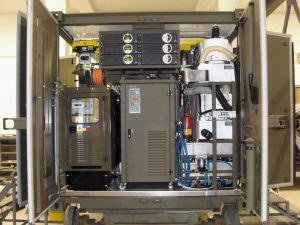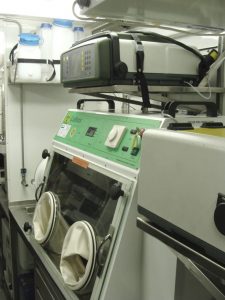Mobile CBRN laboratories
MICHLDESCRIPTION
- Self-sufficient container type laboratory ISO-1C with high level security, special chemical-analytical facility that includes technological area, decontamination module and laboratory area.This Laboratory is equipped with its own communication and control system.
- Laboratory can be transported to its destination place by off road truck TATRA 815 270 R8441300 8×8,2 – equipped with container side loader STEELBRO KL 300/61.Laboratory can also be transported by railways, sea or air.
- The Laboratory performs its tasks in areas adjacent to affected places, not directly in the danger zone, including tasks in urban areas. This Laboratory is suitable for work with the most dangerous chemical materials.
PERFORMANCE
This Laboratory can:
- make a quick qualitative and quantitative analyses of delivered samples of suspicious unknown material from environment affected by assumed chemical attack;
- quickly determine the level of chemical contamination according to AEP-10;
- obtain important information crucial for organization of effective complex radiation, chemical, biological and medical measures;
- identify even more chemicals, dangerous industrial substances and middle-spectrum matters than required by STANAG 4632 annex A, D;
- make supporting analysis which can also determine the level of residual contamination in delivered samples from affected environment;
- evaluate the effectiveness of decontamination processes and control the effectiveness of decontamination agents;


ANALYTICAL METHODS
- Gas Chromatography with Mass Spectrometry -GC/MS (EI), FID.
- High Performance Liquid Chromatography with Mass Spectrometry – HPLC/MS, MS-MS (ESI), DAD and preparatory HPCL.
- Ramanov’s Spectrometry.
- X-ray Fluorescence Spectroscopy.
- Ultraviolet Visible Spectrophotometry UV-VIS.
To process samples, following methods are used:
- Accelerated Solvent Extraction ASE.
- Solid Phase Extraction SPE.
- Solid Phase Microextraction SPME.
TIME
- Time needed to set up the laboratory: up to 1 hour.
- Time needed to prepare the laboratory for work: 1- 4 hours (dependent on the task).
- Time needed to identify an unknown substance – preliminary/final: 2 – 6 hours.
- Analytical control capacity: 40 samples in 12 hours.
- Time of continual operation without replenishing: 12 hours.


